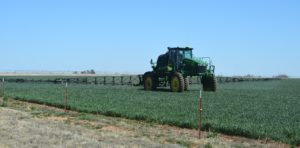Ask your neighbors why Minnesota’s Democratic Party is called the Democratic Farmer Labor Party, and as often as not you will get a sheepish grin, and an “I really don’t know.”
Minnesota’s Farmer-Labor Party had its immediate origins in the spring and summer of 1918, when the Farmer’s Non-Partisan League and the Working People’s Non-Partisan League joined forces to challenge Minnesota’s ruling Republicans by running opposition candidates in the Republican Party primaries. The two movements had little trouble agreeing on a political program. Both opposed the state’s business and political elites. Both favored programs to curb corporate power through state regulations and public ownership.
The previous autumn, organizers from the Farmer’s Non-Partisan League crisscrossed the state, signing up 50,000 farmers on an anti-monopoly program patterned after the successful effort of North Dakota farmers the year before. Opposition was intense. League organizing took place during the heat of U.S. involvement in World War I. Main Street “patriots” busted up meetings and ran organizers out of town. The Republican administration branded both farm and labor militants as disloyal, and jailed leaders for sedition. Governor Burnquist even set up a special commission to suppress dissent. Its chairman, William McGee, set the tone: “The Non- Partisan League lecturer is a traitor every time … Where we made our mistake is in not establishing a firing squad in the first days of the war. We should now get busy and have that firing squad working overtime.”
In late March 1917, Non-Partisan League members nominated the progressive congressman from Little Falls, Charles A. Lindbergh, for governor. In the rally that followed, 7,000 farmers and workers celebrated. The occasion was dramatic. Townley, leader of the Farmers Non-Partisan League, addressed the final session. In the middle of his speech he paused and asked: “Farmers of Minnesota, is there any hatred in your heart toward organized labor?”
The farmers shouted out, “No!” and Townley responded: “Those of you who pledge allegiance to the workers of the city will stand.” Thousands of Minnesota farmers jumped to their feet. “Workers of the city, if you likewise pledge your allegiance to the farmers of Minnesota, please stand.” Immediately the rest of the auditorium was on its feet. Hats sailed through the air, men and women cried. The cheers were tumultuous.
In 1918, Congressman Charles Lindbergh, father of the famous aviator, came within 50,000 votes of defeating Governor J.A.A. Burnquist in the primary. Undeterred, coalition leaders ran a new slate of candidates in the general election. It was the first time the Farmer-Labor label appeared on the state ballot. One hundred years ago, a new political party was born.
In the end, Burnquist was re-elected by a large margin. The Farmer- Laborites, however, kept their coalition together, won a strong foothold in the legislature, and finished well ahead of the hapless Democrats. In 1920 Farmer-Laborites won 46 legislative seats. In 1922, the Farmer-Labor Party elected two of its own to the U.S. Senate. These victories strengthened the hands of those who favored a permanent organizational structure. In 1924, the Labor and Farm Leagues joined forces to create the Farmer- Labor Federation, renamed the Farmer-Labor Association in 1925.
The founders created an organization unique in the history of major American political parties: a year-round constituency-based organization, committed to an anti-monopoly program that challenged the power of the “one percent” of the day. Through its farm and labor organizations and local clubs, the Association educated its members and built a strong base that could withstand efforts to divide along ideological, regional and ethnic lines.
During the the 1920s, the new organization held its own against the Republicans, electing a solid corps of opposition legislators to fight the reform battles of the period. When the “Coolidge Prosperity” turned into the “Hoover Nightmare” of 1929, the party was prepared to move fast. While the rest of the country was spinning in confusion, Minnesota was ready with an organization, a program and tested leadership to become Minnesota’s dominant political party. Floyd B. Olson, the most beloved governor in Minnesota history, held office from 1930 to 1936. Elmer Benson, Minnesota’s most progressive governor, served 1936-38.
At its heart, the FLP was a coalition of prairie populists, democratic socialists and New Deal liberals, with the (controversial) participation of the Communist Party. At its heart was a belief in a “cooperative commonwealth,” a vision that included economic as well as political democracy. With the party’s power fading during World War II, the FLP merged with the Democrats in 1944 to become the DFL.
Today, those who struggle for universal health care, challenge Wall Street, fight for workers’ rights and racial justice carry on, even if unconsciously, the Farmer-Labor tradition. Social inequality is growing. One hundred years later, Farmer-Labor politics are more relevant than ever.























